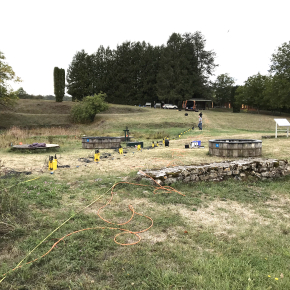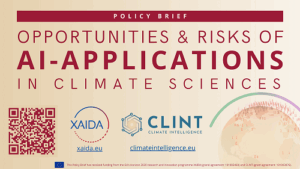Lessening the cost of strategies to reach the Paris Agreement
Balancing CO2 and methane mitigation actions progressively along the way
A team of researchers offer new insight on conversion factors of greenhouse gases into their CO2 equivalent. The publication in Science Advances puts forward the economic benefits of reassessing periodically conversion factors according to scenarios of global warming.
Five researchers[1] shed new light on a key argument to reduce greenhouse gases (GHG): they provided the first economic analysis of conversion factors of other GHG like methane into their CO2 equivalent in overshoot scenarios. Although the United Nations Framework Convention on Climate Change (UNFCCC) considers settling for one value of reference (known as “Common Metric”) to make this conversion among the Paris Agreement, the models presented here show the economic advantage of flexibility between various factors of conversion. «A key notion in the UNFCCC is to reduce GHG emissions in the least costly way so as to ensure global benefits» highlights Katsumasa Tanaka, primary author of the Science Advances study.
The research provides series of dynamic variations of conversion factors depending on possible trajectories of global warming to lessen the economic cost while maintaining some stability to anticipate the implementation of policies. They took into consideration different scenarios, one in which we reach the Paris Agreement’s objectives of stabilization at 2°C and 1.5°C and others in which we would overshoot these objectives and need to strengthen efforts later on. These overshoot scenarios are a violation of the Paris Agreement, but the authors argued that such possibilities cannot be ruled out, in view of the near-term climate policies currently. They further noted that the feasibility of these scenarios still depends on very deep mitigation needed later in this century. They applied conversion factors in the numerical model and simulated the additional mitigation costs in all these scenarios to target the most favourable values.
The choice of a common conversion factor
A conversion system into CO2 equivalent is used to determine the participation of different GHG on a given time to prioritize actions. A well-known example is the global warming potential (GWP). To enable comparison among the parties of the Paris Agreement, the 100-year global warming potential (GWP100) was chosen as a reference. Greenhouse gases having very different lifespan and radiative impact, this conversion system is dependent on the choice of a time horizon.
« With GWP100 we look at the cumulative greenhouse effect on a 100-year period, which for methane gives a conversion factor of 28. This means 1 kilogram of methane is 28 times more potent than a kilogram of CO2 » explains Johannes Morfeldt, a collaborator of this study joined from Sweden. Yet, since methane has a shorter lifespan and a higher radiative impact than CO2, the cumulative effect on 20 years (GWP20) is much more significant: 84 times more than 1 kilogram of CO2.
Changing the time horizon changes the conversion factor, and therefore influences which gas gets high on the agenda. If a kilogram of methane is 84 times more important than one of CO2, it will be more efficient to lower the global emissions by reducing methane. A debate is in motion since the nineties regarding which conversion factor should be used, and this team of researchers meant to bring additional information on their economic cost in light of possible pathways of global warming.

Graph presenting (a) temperature stabilization and overshoot pathways and (b) best available conversion factors for methane under each illustrative pathway.
« We realized with our model that GWP100 is good for the coming decades, but is far from ideal in the long run » says Philippe Ciais, one of the co-authors of the study. « We don’t see much variation in an optimal scenario of stabilization at 2°C. But in the event of an overshoot scenario we observe a high discrepancy among ideal conversion factors for today and when we reach 2°C of global warming. If we do not have a dynamic approach to change these values along the way, then society will bear an additional cost to mitigate climate change» adds Olivier Boucher, another co-author.
An optimal agenda
The researchers then modelled these additional costs to estimate which conversion factor would be ideal at a given time for different temperature trajectories. They showed that setting in stone GWP100 would bring about additional mitigation costs that could be avoided by switching to a dynamic factor. In a scenario of stabilization at 2°C these additional costs round up near 2%, but in high overshoot scenarios it goes up to 5%. « This shows that the ideal factors of conversion depend on a time horizon but are also primarily determined by the pathway, and strongly influenced by a temperature overshoot » underlines Daniel Johansson, a Swedish co-author.
This study shows that adapting to possible trajectories by switching from GWP100 to shorter time-horizons in the future could spare additional mitigation costs compared to the sole use of GWP100. The researchers also understand that these values cannot continuously change to enable policies to be anticipated and implemented. Thus, they put forward series of simple combinations of cost-effective conversion factors depending on the possible pathways. The authors suggest that « the UNFCCC and Parties to the Paris Agreement consider adapting the choice of conversion factors to the future pathway as it unfolds, to implement the cheapest options to reduce greenhouse gases emissions ».
As we do not know yet the long-term pathway, the matter of the cost-effectiveness could be included in the technical assessment supporting the global stocktake within the UNFCCC. This key element of the Paris Agreement evaluates every five years the countries’ collective progress toward long-term goals and aims at increasing the level of ambition of national policies. An inclusion of cost-effectiveness of factors of conversion on this recurring stocktaking process could allow the necessary assessment in time to inform following sessions as the long-term pathway unfolds.
Pour en savoir plus
[1] Katsumasa Tanaka, LSCE-IPSL, CNRS/CEA/UVSQ, Université Paris-Saclay ; NIES, Tsukaba Japan, Olivier Boucher, IPSL/CNRS, Phillipe Ciais, LSCE-IPSL, CNRS/CEA/UVSQ, Université Paris Saclay, Daniel J.A. Johansson et Johannes Morfeldt, Division of Physical Resource Theory, Department of Energy and Environment, Chalmers University of Technology, Gothenburg, Sweden
Reference : Cost-effective implementation of the Paris Agreement using flexible greenhouse gas metrics, K. Tanaka, O. Boucher, P. Ciais, D. J. A. Johansson, and J. Morfeldt, Science Advances (2021)






